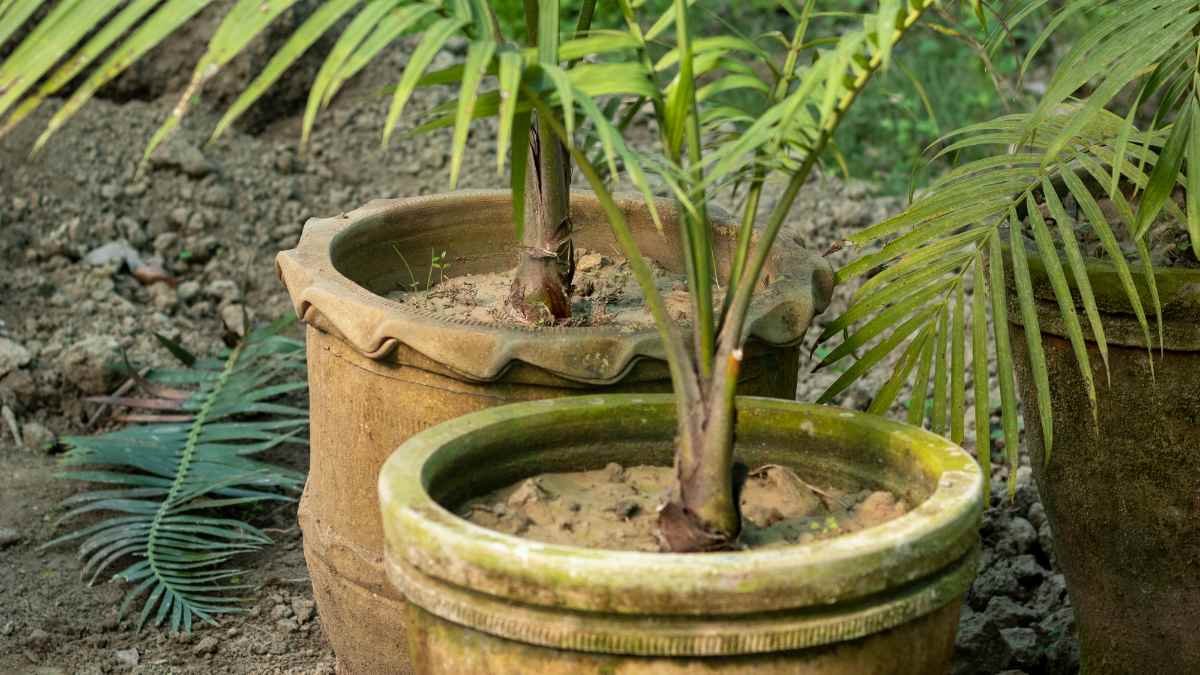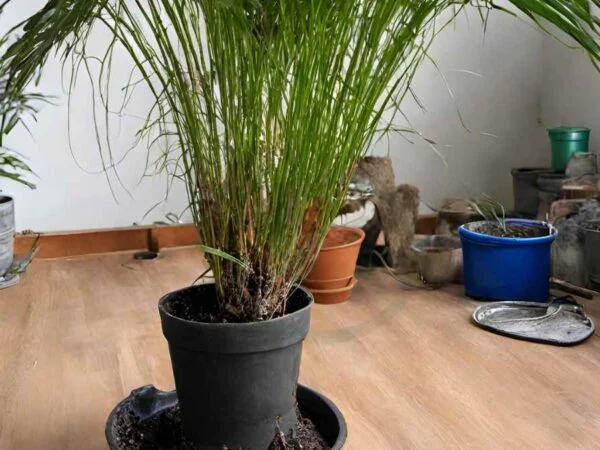
Areca Palm Growth Rate: Wondering about the Areca Palm growth rate of seedlings, indoor plants, and this common houseplant? You're in the right place. Let's explore this together.
Areca Palms are known for their moderate to fast growth rate, typically reaching heights of 6 to 7 feet indoors and up to 20 feet outdoors. Under optimal conditions, these tropical palms can grow several inches per year. Factors such as sunlight, water, temperature, and soil quality significantly influence their growth rate. In general, Areca Palms thrive in well-draining soil and bright, indirect light. Adequate watering and occasional fertilization can promote healthy growth. Keep in mind that individual growth rates may vary based on environmental factors and care practices.
Interested in maximizing your Areca Palm's growth potential? From proper watering techniques to ideal lighting conditions, there's a wealth of information available to help you cultivate lush, thriving palms. Whether you're a seasoned plant enthusiast or just starting your green journey, there are plenty of tips and tricks to explore for nurturing vibrant Areca Palms in your indoor or outdoor space.
Key Takeaways
- Provide Adequate Sunlight: Ensure your areca palm receives bright, indirect sunlight for optimal growth.
- Regular Watering: Maintain consistent watering to keep the soil moist but not waterlogged.
- Consider Indoor Placement: If you live in colder climates, consider growing your areca palm indoors to protect it from harsh weather conditions.
- Balanced Fertilization: Use a balanced fertilizer to promote healthy growth and vibrant foliage.
- Prune Wisely: Prune dead or yellowing fronds to maintain the plant's health and appearance.
- Repot When Necessary: Repot your areca palm when it outgrows its current container to prevent root-bound issues.
Optimal Growing Conditions
Light Exposure
Areca palms thrive in bright, indirect light to promote healthy growth without risking leaf damage. Avoid exposing them to direct sunlight as it can cause burns on the leaves. To ensure even growth, rotate the plant periodically.
Soil Type
For optimal growth, use a well-draining, nutrient-rich potting mix that provides adequate moisture without waterlogging the roots. Consider incorporating peat moss or perlite into the soil mixture to enhance drainage. It is essential to avoid heavy clay soils that may result in root rot.
Watering Needs
Maintain the health of your areca palm by watering it when the top inch of soil feels dry to the touch. It is crucial to strike a balance between keeping the soil moist and preventing waterlogging, which can lead to root issues. Adjust your watering schedule based on seasonal changes to meet the plant's evolving needs.
Temperature Range
To ensure optimal growth, maintain temperatures above 50°F (10°C) for your areca palm. Shield the plant from cold drafts that could induce stress and hinder its development. The ideal temperature range for vibrant growth falls between 65-75°F (18-24°C).
Humidity Levels
Creating a humid environment with levels of at least 50% humidity is vital for the well-being of your areca palm. Regularly misting the leaves helps elevate humidity levels around the plant. For consistent moisture, you may opt to use a humidifier in the vicinity of the plant.
Planting and Propagation
Seed Germination
To kickstart seed germination, soak them in warm water for 24 hours. Then, plant them in well-draining soil. Maintain warmth and consistent moisture for successful germination.
Propagation Techniques
For propagation, divide mature plants ensuring each division has roots and shoots. Rooting hormone can be used to boost root development effectively.
Indoor vs Outdoor Growth
Indoor Care Tips
Indoor areca palms should be kept away from cold drafts to prevent stress on the plant. Regularly clean the leaves to avoid dust accumulation, which can hinder photosynthesis. Monitor for pests and diseases by checking the leaves and stems frequently.
Outdoor Planting Guide
When planting outdoors, select a location with partial shade and protection from direct sunlight. Consider the mature height of the palm when spacing plants to allow proper growth. Shield young plants from strong winds and extreme weather to promote healthy development.
Fertilization Strategies
Fertilizer Types
Areca palms thrive with balanced liquid fertilizer to support their growth needs effectively. Opt for a nitrogen-rich fertilizer to promote the development of lush foliage. Avoid over-fertilizing as it can lead to nutrient imbalances and harm the plant.
When choosing a fertilizer for your areca palm, ensure it provides the necessary nutrients without causing harm or imbalance. Here are some key points to consider:
- Use balanced liquid fertilizer for optimal growth.
- Opt for a nitrogen-rich fertilizer for lush foliage.
- Avoid over-fertilizing to prevent nutrient imbalances.
Application Schedule
For optimal growth, fertilize your areca palm during the growing season, which typically falls in spring and summer months. To ensure the best results, apply fertilizer every 4-6 weeks during this period. During the dormant winter months, reduce fertilization to support the plant's natural growth cycle.
Consider creating a schedule to keep track of your areca palm's fertilization routine. Here are some guidelines to follow:
- Fertilize during the growing season (spring and summer).
- Apply fertilizer every 4-6 weeks for best results.
- Reduce fertilization during the dormant winter months.
Pruning and Maintenance
Pruning Techniques
Prune yellow or brown fronds near the trunk to maintain the plant's health and appearance. Removing old, leggy stems encourages fresh growth and enhances the overall look of the areca palm. Remember to sterilize pruning tools after each use to prevent infections from spreading.
Maintenance Routine
Regularly inspect your areca palm for signs of pests and diseases such as yellowing leaves or unusual spots. Dusting the leaves with a soft cloth helps in improving photosynthesis by allowing better light absorption. Check the roots for overcrowding, which may indicate the need for repotting to ensure proper growth.
Potting and Repotting
Choosing Pots
When potting areca palms, it's crucial to select pots with drainage holes at the bottom. This prevents waterlogging, which can lead to root rot. Opt for a pot that is slightly larger than the current one to accommodate the plant's growth. Lightweight materials like plastic or fiberglass make moving the pot easier.
Repotting Steps
To ensure healthy growth, repot your areca palm every 2-3 years. This process helps refresh the soil and provides more space for root development. Before placing the plant in the new pot, gently loosen the roots to encourage new growth. After repotting, water thoroughly to reduce transplant shock and help the plant adjust to its new environment.
Pest and Disease Management
Common Pests
Watch out for spider mites, mealybugs, and scale insects. These pests can damage the Areca Palm by feeding on its leaves and sap. Treat pests with neem oil or insecticidal soap, which are effective and safe solutions. Isolate infected plants to prevent the spread of pests to other plants in your indoor garden.
Disease Prevention
To prevent root rot, ensure proper drainage in the potting soil of your Areca Palm. Avoid overwatering, as it can lead to fungal diseases that harm the plant. When introducing new plants, quarantine them initially to prevent the introduction of diseases into your existing plant collection.
Growth Rate Insights
Growth Expectations
Areca palms exhibit slow to moderate growth of 6-10 inches annually, requiring up to ten years to attain full height. Providing optimal care ensures consistent growth rates.
Maximizing Growth
To maximize growth, ensure the plant receives adequate light, water, and nutrients. Regular pruning promotes healthy new growth. Monitor for signs of stress to adjust care accordingly.
Landscaping with Areca Palms
Design Ideas
Areca palms can serve as focal points in indoor spaces, adding a touch of elegance and tropical vibes. To create a tropical oasis, consider clustering several palms together in a corner or near a window. For a more dynamic look, combine areca palms with other houseplants to create a diverse and visually appealing indoor garden.
Spacing Requirements
Indoor areca palms should be spaced at least 5 feet apart to ensure they have enough room to grow without overcrowding. When planting outdoor areca palms, it's crucial to allow ample space for them to reach their full height and spread. Consider the mature spread of the palm when determining the proper spacing to avoid issues as they grow.
Summary
In understanding the growth rate of Areca palms, you have explored optimal conditions, planting techniques, fertilization strategies, and more. By now, you are equipped with insights into maintaining these beautiful plants both indoors and outdoors, ensuring their health and vibrancy. Remember to implement proper pruning practices and stay vigilant against pests to promote robust growth.
To continue fostering a thriving Areca palm garden, apply the knowledge gained here diligently. Share your newfound expertise with fellow gardening enthusiasts to create lush landscapes together. Stay committed to providing the best care for your Areca palms and watch them flourish in return.
Frequently Asked Questions
What are the optimal growing conditions for Areca Palms?
Areca palms thrive in bright, indirect light and well-draining soil. They prefer temperatures between 65-75°F (18-24°C) and high humidity levels. Regular watering to keep the soil moist but not waterlogged is essential for their growth.
How should I fertilize Areca Palms for optimal growth?
Use a balanced liquid fertilizer diluted to half strength during the growing season. Apply every 4-6 weeks to provide essential nutrients. Avoid over-fertilizing, as it can lead to nutrient imbalances and damage the plant.
When is the best time for pruning and maintenance of Areca Palms?
Prune yellowing or damaged fronds throughout the year to maintain plant health. Trim back brown tips using sterile pruners to promote new growth. Regularly remove spent blooms and debris to prevent pest infestations and diseases.
How often should I repot my Areca Palm?
Repot your Areca Palm every 2-3 years in spring if it has outgrown its current container. Choose a slightly larger pot with good drainage holes and fresh potting mix. Gently loosen the roots during repotting to encourage healthy growth.
Can Areca Palms be grown indoors and outdoors?
Areca palms can be grown both indoors and outdoors, depending on your climate. Indoors, they require bright, indirect light and consistent humidity levels. Outdoors, they thrive in partial shade or filtered sunlight in tropical or subtropical regions.
Image Source: Paid image from CANVA





